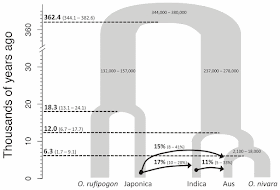I have previously discussed the use of phylogenetic networks to study the Complex hybridizations in wheat, due to the very reticulate evolutionary history. It seems that the situation for the other major world food source, rice, also requires network analysis, although this time introgression is the biological source of reticulation, rather than hybridization.
Jae Young Choi, Adrian E. Platts, Dorian Q. Fuller, Yue-Ie Hsing, Rod A. Wing, and Michael D. Purugganan (2017) The rice paradox: multiple origins but single domestication in Asian rice. Molecular Biology & Evolution 34: 969-979.
The authors note:
The Asian rice Oryza sativa is the world’s most important food crop, and is a staple for more than one-third of the world’s population. Oryza sativa is genetically differentiated into several groups, the main ones being japonica and indica, which have been considered as subspecies / subpopulations with distinct morphological and physiological characteristics
The origin of domesticated Asian rice has been a contentious topic, with conflicting evidence for either single or multiple domestication of this key crop species. We examined the evolutionary history of domesticated rice by analyzing de novo assembled genomes from domesticated rice and its wild progenitors. Our results indicate multiple origins, where each domesticated rice subpopulation (japonica, indica, and aus) arose separately from progenitor O. rufipogon and / or O. nivara.
We also show that there is significant gene flow from japonica to both indica (c. 17%) and aus (c. 15%), which led to the transfer of domestication alleles from early-domesticated japonica to proto-indica and proto-aus populations. Our results provide support for a model in which different rice subspecies had separate origins, but that de novo domestication occurred only once, in O. sativa ssp. japonica, and introgressive hybridization from early japonica to proto-indica and proto-aus led to domesticated indica and aus rice.Similar reticulation histories have, of course, been reported for most domesticated organisms (see Are phylogenetic trees useful for domesticated organisms?), including dogs, cattle, horses, sheep, grapes, etc.


No comments:
Post a Comment